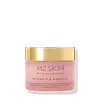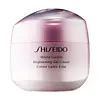What's inside
What's inside
 Key Ingredients
Key Ingredients

 Benefits
Benefits

 Concerns
Concerns

 Ingredients Side-by-side
Ingredients Side-by-side

Water
Skin ConditioningEthylhexyl Methoxycinnamate
UV AbsorberEthylhexyl Salicylate
UV AbsorberIsoamyl Laurate
EmollientTribehenin PEG-20 Esters
EmollientGlycerin
HumectantButyrospermum Parkii Butter
Skin ConditioningSilica
AbrasiveCaprylic/Capric Triglyceride
MaskingCaryodendron Orinocense Seed Oil
EmollientSqualane
EmollientTitanium Dioxide
Cosmetic ColorantButyl Methoxydibenzoylmethane
UV AbsorberCetearyl Alcohol
EmollientMyristyl Myristate
EmollientPhenoxyethanol
PreservativeOlive Glycerides
EmulsifyingAdipic Acid/Neopentyl Glycol Crosspolymer
Sucrose Palmitate
EmollientAscorbyl Tetraisopalmitate
AntioxidantCeteareth-20
CleansingBenzyl Alcohol
PerfumingGlycine Soja Oil
EmollientTriethanolamine
BufferingGlyceryl Linoleate
EmollientTocopheryl Acetate
AntioxidantSodium Hyaluronate
HumectantCarbomer
Emulsion StabilisingPolyacrylamide
Ceramide NP
Skin ConditioningParfum
MaskingAlumina
AbrasiveC13-14 Isoparaffin
EmollientDisodium EDTA
Ethylhexylglycerin
Skin ConditioningTocopherol
AntioxidantPolyurethane Crosspolymer-1
Retinol
Skin ConditioningDehydroacetic Acid
PreservativeLaureth-7
EmulsifyingCitric Acid
BufferingHexyl Cinnamal
PerfumingCaprylyl Glycol
EmollientPotassium Sorbate
PreservativeLinalool
PerfumingBHT
AntioxidantBenzyl Salicylate
PerfumingHydroxycitronellal
PerfumingAlpha-Isomethyl Ionone
PerfumingCitronellol
PerfumingGeraniol
PerfumingLimonene
PerfumingGlyceryl Caprylate
EmollientWater, Ethylhexyl Methoxycinnamate, Ethylhexyl Salicylate, Isoamyl Laurate, Tribehenin PEG-20 Esters, Glycerin, Butyrospermum Parkii Butter, Silica, Caprylic/Capric Triglyceride, Caryodendron Orinocense Seed Oil, Squalane, Titanium Dioxide, Butyl Methoxydibenzoylmethane, Cetearyl Alcohol, Myristyl Myristate, Phenoxyethanol, Olive Glycerides, Adipic Acid/Neopentyl Glycol Crosspolymer, Sucrose Palmitate, Ascorbyl Tetraisopalmitate, Ceteareth-20, Benzyl Alcohol, Glycine Soja Oil, Triethanolamine, Glyceryl Linoleate, Tocopheryl Acetate, Sodium Hyaluronate, Carbomer, Polyacrylamide, Ceramide NP, Parfum, Alumina, C13-14 Isoparaffin, Disodium EDTA, Ethylhexylglycerin, Tocopherol, Polyurethane Crosspolymer-1, Retinol, Dehydroacetic Acid, Laureth-7, Citric Acid, Hexyl Cinnamal, Caprylyl Glycol, Potassium Sorbate, Linalool, BHT, Benzyl Salicylate, Hydroxycitronellal, Alpha-Isomethyl Ionone, Citronellol, Geraniol, Limonene, Glyceryl Caprylate
Water
Skin ConditioningButylene Glycol
HumectantGlycerin
HumectantDimethicone
EmollientSd Alcohol 40-B
AstringentTriethylhexanoin
MaskingPEG/PPG-14/7 Dimethyl Ether
Skin ConditioningHydrogenated Polydecene
EmollientBehenyl Alcohol
EmollientStearyl Alcohol
EmollientMyristyl Myristate
EmollientGlyceryl Stearate Se
EmulsifyingTrehalose
HumectantPotassium Methoxysalicylate
BleachingPhytosteryl Macadamiate
Skin ConditioningMethyl Methacrylate Crosspolymer
Polysorbate 60
EmulsifyingPEG-40 Stearate
EmulsifyingPhenoxyethanol
PreservativeDimethylacrylamide/Sodium Acryloyldimethyltaurate Crosspolymer
Hydrogenated Palm Oil
EmollientElaeis Guineensis Kernel Oil
EmollientElaeis Guineensis Oil
EmollientSorbitan Tristearate
EmulsifyingTrisodium EDTA
Erythritol
HumectantPEG/PPG-17/4 Dimethyl Ether
Skin ConditioningSodium Citrate
BufferingParfum
MaskingDipotassium Glycyrrhizate
Humectant2-O-Ethyl Ascorbic Acid
Skin ConditioningAlcohol
AntimicrobialSilica
AbrasiveXanthan Gum
EmulsifyingCaffeine
Skin ConditioningLinalool
PerfumingCitric Acid
BufferingSodium Metaphosphate
BufferingPPG-3 Dipivalate
Skin ConditioningHdi/Trimethylol Hexyllactone Crosspolymer
Tocopherol
AntioxidantCitronellol
PerfumingSodium Metabisulfite
AntioxidantGeraniol
PerfumingAngelica Keiskei Leaf/Stem Extract
Skin ConditioningLimonene
PerfumingPaeonia Albiflora Root Extract
Skin ConditioningCrataegus Monogyna Flower Extract
Skin ConditioningAcrylates/C10-30 Alkyl Acrylate Crosspolymer
Emulsion StabilisingFructose
HumectantRehmannia Chinensis Root Extract
Skin ConditioningCI 77491
Cosmetic ColorantPrunus Yedoensis Leaf Extract
Skin ConditioningZiziphus Jujuba Fruit Extract
Skin ConditioningPyrola Incarnata Extract
Skin ConditioningPotentilla Erecta Root Extract
Skin ConditioningPolyquaternium-51
Skin ConditioningBenzoic Acid
MaskingWater, Butylene Glycol, Glycerin, Dimethicone, Sd Alcohol 40-B, Triethylhexanoin, PEG/PPG-14/7 Dimethyl Ether, Hydrogenated Polydecene, Behenyl Alcohol, Stearyl Alcohol, Myristyl Myristate, Glyceryl Stearate Se, Trehalose, Potassium Methoxysalicylate, Phytosteryl Macadamiate, Methyl Methacrylate Crosspolymer, Polysorbate 60, PEG-40 Stearate, Phenoxyethanol, Dimethylacrylamide/Sodium Acryloyldimethyltaurate Crosspolymer, Hydrogenated Palm Oil, Elaeis Guineensis Kernel Oil, Elaeis Guineensis Oil, Sorbitan Tristearate, Trisodium EDTA, Erythritol, PEG/PPG-17/4 Dimethyl Ether, Sodium Citrate, Parfum, Dipotassium Glycyrrhizate, 2-O-Ethyl Ascorbic Acid, Alcohol, Silica, Xanthan Gum, Caffeine, Linalool, Citric Acid, Sodium Metaphosphate, PPG-3 Dipivalate, Hdi/Trimethylol Hexyllactone Crosspolymer, Tocopherol, Citronellol, Sodium Metabisulfite, Geraniol, Angelica Keiskei Leaf/Stem Extract, Limonene, Paeonia Albiflora Root Extract, Crataegus Monogyna Flower Extract, Acrylates/C10-30 Alkyl Acrylate Crosspolymer, Fructose, Rehmannia Chinensis Root Extract, CI 77491, Prunus Yedoensis Leaf Extract, Ziziphus Jujuba Fruit Extract, Pyrola Incarnata Extract, Potentilla Erecta Root Extract, Polyquaternium-51, Benzoic Acid
Ingredients Explained
These ingredients are found in both products.
Ingredients higher up in an ingredient list are typically present in a larger amount.
Citric Acid is an alpha hydroxy acid (AHA) naturally found in citrus fruits like oranges, lemons, and limes.
Like other AHAs, citric acid can exfoliate skin by breaking down the bonds that hold dead skin cells together. This helps reveal smoother and brighter skin underneath.
However, this exfoliating effect only happens at high concentrations (20%) which can be hard to find in cosmetic products.
Due to this, citric acid is usually included in small amounts as a pH adjuster. This helps keep products slightly more acidic and compatible with skin's natural pH.
In skincare formulas, citric acid can:
While it can provide some skin benefits, research shows lactic acid and glycolic acid are generally more effective and less irritating exfoliants.
Most citric acid used in skincare today is made by fermenting sugars (usually from molasses). This synthetic version is identical to the natural citrus form but easier to stabilize and use in formulations.
Read more about some other popular AHA's here:
Learn more about Citric AcidCitronellol is used to add fragrance/parfum to a product. It is often derived from plants such as roses. In fact, it can be found in many essential oils including geranium, lavender, neroli, and more. The scent of Citronellol is often described as "fresh, grassy, and citrus-like".
Since the Citronellol molecule is already unstable, Citronellol becomes irritating on the skin when exposed to air.
Citronellol is a modified terpene. Terpenes are unsaturated hydrocarbons found in plants. They make up the primary part of essential oils.
Citronellol is not able to be absorbed into deeper layers of the skin. It has low permeability,
Citronellol is also a natural insect repellent.
Learn more about CitronellolGeraniol is used to add fragrance/parfum to a product. It is the main component of citronellol. It is a monoterpenoid and an alcohol.
Monoterpenes are naturally found in many parts of different plants.
Geraniol can be found in many essential oils including Rose Oil and Citronella Oil. The scent of Geraniol is often described as "rose-like". Many foods also contain Geraniol for fruit flavoring.
Geraniol can irritate the skin when exposed to air. However, irritation depends on the ability of geraniol to penetrate into the skin. In general, geraniol is not able to penetrate skin easily.
Geraniol is colorless and has low water-solubility. However, it is soluble in common organic solvents.
Like citronellol, it is a natural insect repellent.
2,6-Octadien-1-ol, 3,7-dimethyl-, (2E)-
Learn more about GeraniolGlycerin is already naturally found in your skin. It helps moisturize and protect your skin.
A study from 2016 found glycerin to be more effective as a humectant than AHAs and hyaluronic acid.
As a humectant, it helps the skin stay hydrated by pulling moisture to your skin. The low molecular weight of glycerin allows it to pull moisture into the deeper layers of your skin.
Hydrated skin improves your skin barrier; Your skin barrier helps protect against irritants and bacteria.
Glycerin has also been found to have antimicrobial and antiviral properties. Due to these properties, glycerin is often used in wound and burn treatments.
In cosmetics, glycerin is usually derived from plants such as soybean or palm. However, it can also be sourced from animals, such as tallow or animal fat.
This ingredient is organic, colorless, odorless, and non-toxic.
Glycerin is the name for this ingredient in American English. British English uses Glycerol/Glycerine.
Learn more about GlycerinLimonene is a fragrance that adds scent and taste to a formulation.
It's found in the peel oil of citrus fruits and other plants such as lavender and eucalyptus. The scent of limonene is generally described as "sweet citrus".
Limonene acts as an antioxidant, meaning it helps neutralize free radicals.
When exposed to air, oxidized limonene may sensitize the skin. Because of this, limonene is often avoided by people with sensitive skin.
The term 'fragrance' is not regulated in many countries. In many cases, it is up to the brand to define this term. For instance, many brands choose to label themselves as "fragrance-free" because they are not using synthetic fragrances. However, their products may still contain ingredients such as essential oils that are considered a fragrance.
Learn more about LimoneneLinalool is a fragrance and helps add scent to products. It's derived from common plants such as cinnamon, mint, citrus, and lavender.
Like Limonene, this ingredient oxidizes when exposed to air. Oxidized linalool can cause allergies and skin sensitivity.
This ingredient has a scent that is floral, spicy tropical, and citrus-like.
Learn more about LinaloolMyristyl Myristate is created from the fatty acids of myristyl alcohol and myristic acid. In skincare, it is an emollient and texture enhancer.
On its own, this ingredient has a comedogenicity index of 5/5. This means it has the potential to clog pores. When diluted with cetyl alcohol or propylene glycol, the comedogenicity will decrease.
This ingredient may not be Malassezia folliculitis, or fungal-acne safe.
Nutmeg, palm kernel oil, and coconut oil all contain this ingredient naturally.
Learn more about Myristyl MyristateParfum is a catch-all term for an ingredient or more that is used to give a scent to products.
Also called "fragrance", this ingredient can be a blend of hundreds of chemicals or plant oils. This means every product with "fragrance" or "parfum" in the ingredients list is a different mixture.
For instance, Habanolide is a proprietary trade name for a specific aroma chemical. When used as a fragrance ingredient in cosmetics, most aroma chemicals fall under the broad labeling category of “FRAGRANCE” or “PARFUM” according to EU and US regulations.
The term 'parfum' or 'fragrance' is not regulated in many countries. In many cases, it is up to the brand to define this term.
For instance, many brands choose to label themselves as "fragrance-free" because they are not using synthetic fragrances. However, their products may still contain ingredients such as essential oils that are considered a fragrance by INCI standards.
One example is Calendula flower extract. Calendula is an essential oil that still imparts a scent or 'fragrance'.
Depending on the blend, the ingredients in the mixture can cause allergies and sensitivities on the skin. Some ingredients that are known EU allergens include linalool and citronellol.
Parfum can also be used to mask or cover an unpleasant scent.
The bottom line is: not all fragrances/parfum/ingredients are created equally. If you are worried about fragrances, we recommend taking a closer look at an ingredient. And of course, we always recommend speaking with a professional.
Learn more about ParfumPhenoxyethanol is a preservative that has germicide, antimicrobial, and aromatic properties. Studies show that phenoxyethanol can prevent microbial growth. By itself, it has a scent that is similar to that of a rose.
It's often used in formulations along with Caprylyl Glycol to preserve the shelf life of products.
Silica, also known as silicon dioxide, is a naturally occurring mineral. It is used as a fine, spherical, and porous powder in cosmetics.
Though it has exfoliant properties, the function of silica varies depending on the product.
The unique structure of silica enhances the spreadability and adds smoothness, making it a great texture enhancer.
It is also used as an active carrier, emulsifier, and mattifier due to its ability to absorb excess oil.
In some products, tiny microneedles called spicules are made from silica or hydrolyzed sponge. When you rub them in, they lightly polish away dead skin layers and enhance the penetration of active ingredients.
Learn more about SilicaTocopherol (also known as Vitamin E) is a common antioxidant used to help protect the skin from free-radicals and strengthen the skin barrier. It's also fat soluble - this means our skin is great at absorbing it.
Vitamin E also helps keep your natural skin lipids healthy. Your lipid skin barrier naturally consists of lipids, ceramides, and fatty acids. Vitamin E offers extra protection for your skin’s lipid barrier, keeping your skin healthy and nourished.
Another benefit is a bit of UV protection. Vitamin E helps reduce the damage caused by UVB rays. (It should not replace your sunscreen). Combining it with Vitamin C can decrease sunburned cells and hyperpigmentation after UV exposure.
You might have noticed Vitamin E + C often paired together. This is because it is great at stabilizing Vitamin C. Using the two together helps increase the effectiveness of both ingredients.
There are often claims that Vitamin E can reduce/prevent scarring, but these claims haven't been confirmed by scientific research.
Learn more about TocopherolWater. It's the most common cosmetic ingredient of all. You'll usually see it at the top of ingredient lists, meaning that it makes up the largest part of the product.
So why is it so popular? Water most often acts as a solvent - this means that it helps dissolve other ingredients into the formulation.
You'll also recognize water as that liquid we all need to stay alive. If you see this, drink a glass of water. Stay hydrated!
Learn more about Water